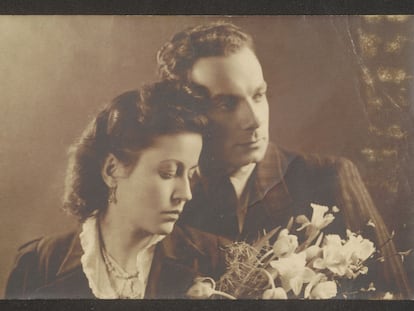Auschwitz in the era of dark tourism
On the 80th anniversary of the concentration camp’s liberation, its significance is being trivialized by tourism and popular culture. At the same time, this symbol of evil is being transformed and opened up to new forms of commemoration
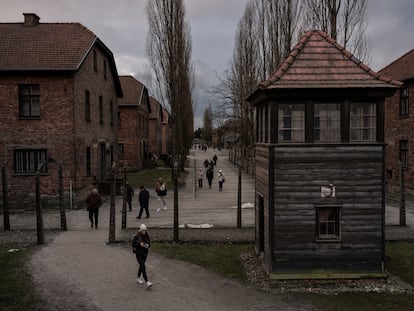
“Auschwitz with lunch included.” The inspiration for Jesse Eisenberg to shoot the Oscar-nominated A Real Pain, came to him unexpectedly: through an internet advertisement for a visit to the concentration camp, which on Monday commemorates the 80th anniversary of its liberation in 1945.
The advert was promoting a type cultural tourism that has been gaining traction in recent years. It invites us to visit the various sites of the Holocaust and relive the trauma of the victims, in comfort and style. The story of two American cousins, David and Benji, who visit Poland, a country from which their recently deceased grandmother escaped, was thus inspired. Eisenberg shot the movie in the city of Lublin and in the Majdanek camp, which he had visited in 2008. His own ancestors lived just around the corner.
Eisenberg’s focus is not unique. In 2025, Holocaust cinema is no longer about the victims or survivors, but about tourists who decide to visit the scene of last century’s most horrendous crime. In Treasure, released last fall, a young woman travels to Auschwitz with her father, a Polish Jew who escaped extermination. The trip take place in post-communist Poland in 1991.
In Delegation, screened at the last Berlinale, a group of Israeli teenagers wrapped in their country’s flag, visit the camp to understand what happened. The documentary Austerlitz, by Ukrainian director Sergey Loznitsa, takes a look at the hordes of tourists in the former concentration camps. And The Zone of Interest, inspired by the story of Auschwitz commandant Rudolf Höss and his wife, who lived next door to the death camp without taking any interest in the horrors taking place inside, ends by fast forwarding to the present. Director Jonathan Glazer takes us to the actual Auschwitz Museum, where cleaners and other workers prepare for the arrival of the multitude of visitors who, every day, cross the grim threshold under a sign that reads Arbeit macht frei — work will set you free. The memorials are not new — Auschwitz opened to the public as early as 1947 — but they have never seen so many visitors. In 2024, 1.83 million people passed through the camp, 10% more than the previous year.
Eight decades after its liberation, Auschwitz remains a symbol of absolute evil, but it is also a symbol of dark tourism, that fascination with death and foul deeds that makes us visit battlefields and disaster areas, former prisons and scenes of genocide. We do it out of empathy with the victims and out of civic responsibility, following the duty-to-remember edict. But there is also an element of voyeurism which has helped transform this camp into a tourist center like no other, where one can eat, drink, go to the bathroom and even take a selfie next to the gas chambers.
In 2014, the smiling selfie of a teenager in Auschwitz-Birkenau, accompanied by an equally smiling emoji, sparked a controversy on social media. The installation of water vaporizers at the camp entrance to alleviate the summer heat didn’t help either. Auschwitz responded that the controversy was unjustified: Zyklon B, the deadly gas with which the Jews were annihilated, was spewed out “in a totally different way.” In that case, all is in order.
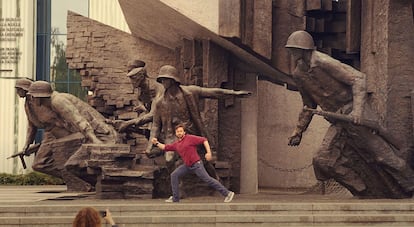
Each anniversary of the liberation of the death camp takes place within a particular political context. The anniversary commemorated on Monday, January 27, is marked by the disappearance of all but a handful of survivors, by the destruction of Gaza and the rise of the extreme right in many parts of Europe, including Germany, which is warping all the postwar precepts of our collective historical memory.
The re-election of Donald Trump also seems to put an end to the international order that emerged after the war, as he withdraws the U.S. from institutions created after 1945. “Culturally, it’s an incredible change,” says French historian Annette Wieviorka, one of the world’s leading Holocaust specialists. “The world in which people like me grew up and learned to think is disappearing. Now we are told that freedom of speech also comes with the right to lie. This 80th anniversary comes in the midst of a transition to a new world that we no longer know what to make of.”
Wieviorka recalls the commemoration 20 years ago, when she believed that history had won. “That is, that the historical account of what happened at Auschwitz had entered the collective consciousness. Now we realize that everything can be undone. Auschwitz remains a symbol of horror, but the taboos have been lifted. Everything has become possible.” This includes the selfies in front of the barbed wire, and the opening to the public of Rudolf Höss’ house, where The Zone of Interest was filmed, as well as the proliferation of books with the word “Auschwitz” in the title.
It is as if the camp has become a kind of trademark: The Ballerina of Auschwitz, The Orphan of Auschwitz, Lovers in Auschwitz, The Midwife of Auschwitz, The Tattooist of Auschwitz, The Sisters of Auschwitz, The Auschwitz Photographer, The Librarian of Auschwitz and The Dressmakers of Auschwitz. The days of Primo Levi and Elie Wiesel are far behind us. “Everything is now about emotion,” Wieviorka says. “Emotions are indispensable for understanding the Shoah, but when everything is reduced to emotion, one wonders what it is for.”
Has Auschwitz become normalized? “Not yet,” she says, “but there is a progressive trivialization. The tendency is to use the culture industries to depict episodes of history, like the creation of an endless number of historical Disneylands. For the moment, this is not the case with Auschwitz or Birkenau, which are still extermination camps, but the future is not promising.”
Despite this tendency to dilute historical memory by making it popular and spectacular, not everything is trivialized. The last two films about the camps that have reached movie theaters prove this. A Real Pain includes a comic scene where the protagonists pretend to participate in the war, which ironizes this tendency to trivialize these scenarios. In another scene, the more depressive cousin suffers an anxiety attack when he realizes he is traveling by train to the same place his grandmother did decades earlier, only this time of his own free will — and in first class.
But the film is also a meditation on the generational transference of trauma and the relativity, when compared to that of their ancestors, of that “real pain” experienced by its protagonists, both of whom have mental health issues. It speaks of the (self-)destructive drive of the contemporary Jew and his inevitable wandering, as reflected in another brilliant sequence in which the cousins visit their grandmother’s old home, from which she had to escape.
In Treasure, the protagonist, a journalist played by Lena Dunham, accompanies her Holocaust survivor father to Auschwitz, although in the end it is she, dealing with an eating disorder and chronic dissatisfaction with life, who ends up healing her neurosis. How does one explain that the point of view is no longer that of the victims, but that of their descendants?
“We filmmakers of the third generation after 1945 need to break the silence we grew up with,” argues Treasure’s director, Germany’s Julia von Heinz, who admits to similarities with Eisenberg’s film. “This was not only the case with the families of the victims — due to shame, trauma, trying to give their children a normal life and a desire not to be victimized anymore — but also with the families of those who committed the crimes.”
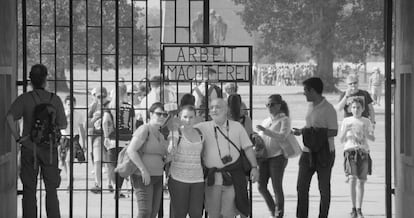
On the other hand, the field of study of transgenerational trauma is relatively recent. “Twenty years ago, this was not talked about,” says Von Heinz. “Now we know that every traumatic experience is passed on to the next generation, who have nightmares about the suffering of their parents and grandparents even if they have never been told about it. That’s where these films come from.”
From the “era of the witness” examined by Wieviorka, which refers to the proliferation of testimonies that followed the televised trial of Adolf Eichmann in 1961, we have moved on to “an era of post-memory, in which the transmission of experience will no longer take place through people, but through places,” according to museology researcher Nathanaël Wadbled. The memorial route is not disappearing, but it is being transformed. And in this sense, tourism might not just be disrespectful and futile, but instead a new form of commemoration, that of our time.
It is 40 years since the premiere of Shoah, Claude Lanzmann’s definitive documentary about the annihilation of six million Jews, more than one million of whom were murdered in Auschwitz. It consists of nine and a half hours of footage covering the testimonies of victims and executioners. It was released in April 1985 after 11 years in the making, and 300 hours of filming. Next month, the Berlinale will pay tribute to this monumental piece of work that has become a cinematographic and moral benchmark: a film without narration, archives or reconstructions, without dramatic manipulation of the unspeakable.
“Fiction is a transgression. I am deeply convinced that there is a ban on representation,” Lanzmann said in 1994 in his famous diatribe in Le Monde against Schindler’s List, which he defined as “a kitschy melodrama” and “an illustrated version of Shoah, he has supplied images where there were none in Shoah.” Lanzmann said that if he had found a graphic document of Auschwitz, he would have destroyed it.
Life is Beautiful, in which Roberto Benigni turned existence in the extermination camp almost into a children’s scavenger hunt, was also a victim of German philosopher Theodore Adorno’s moral veto suggesting “to write poetry after Auschwitz is barbarism.” Although, in hindsight, perhaps Imre Kertész, a survivor of the camp, may have won when he stated the opposite. “I am totally against Adorno’s phrase. After Auschwitz we can write nothing but fiction,” said the Hungarian writer in 2001. “If someone were to tell what really happened in Auschwitz, we would be unable to understand it.”
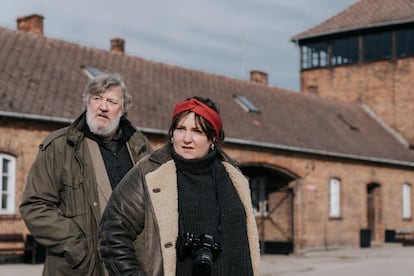
In the decade between 1985 and 1994, the film department of the Yad Vashem memorial in Jerusalem registered more than 1,000 films about the Holocaust. To avoid manipulation, the Auschwitz Museum offers timely advice to filmmakers. For example, the director of its research center, Piotr Setkiewicz, was Jonathan Glazer’s main advisor on The Zone of Interest, an adaptation of Martin Amis’ novel that was also inspired by historian Timothy Snyder’s theses. “Every film of this kind fulfills an important outreach role, since the number of viewers is much larger than the number of readers of scientific books,” Setkiewicz says. “I am irritated by films that reflect false stories despite claiming to be based on eyewitness accounts.”
“This was not the case with The Zone of Interest,” Setkiewicz adds. “From the beginning I understood that the historical aspect of the film would be as important as the artistic concept. I tried to help recreate the most likely scenes and dialogues that, to the best of my knowledge, could have happened. The result is satisfactory, although more attentive viewers may notice minor factual inaccuracies in the film: Mr. Glazer did not always accept my orthodox approach.”
The Dutch historian Robert Jan van Pelt, curator of the large touring exhibition dedicated to the history of the camp, has visited Auschwitz more than 80 times. At first, at the end of the 1980s, he used to spend an hour and a half in the camp. Now he spends up to four days. “The camp has been expanding and has been provided with an infrastructure to accommodate hundreds of tours a day. Paradoxically, Auschwitz has become a tourist destination, one to cross off on a list of places to travel to,” he says. “Its nature has changed, but it will never be a museum like any other, because it is still a sacred site, because of the suffering that took place there and because of its immense size.”
As far as Van Pelt is concerned, the change in generational perspective is crucial. “The last survivors are dying and their first-hand perspective is disappearing. The question is what our relationship to these places will now be. What will an 18- 25- or 30-year-old who has not grown up with these testimonies see? What will these places mean to him?”
The two cousins from A Real Pain provide a possible answer. All the neurotic, mocking noise they make on their journey to Majdanek, crossing a point on the map that was once a kind of Jewish Oxford, turns to categorical silence when they end up entering the camp. They return, sad and shaken, in a vehicle that advances towards the horizon, as happened at the end of Shoah. The difference is that it is not a train that advances without stopping, suggesting “that the Holocaust has no ending,” as Lanzmann once said. The cousins are returning on a tourist minibus.
Sign up for our weekly newsletter to get more English-language news coverage from EL PAÍS USA Edition
Tu suscripción se está usando en otro dispositivo
¿Quieres añadir otro usuario a tu suscripción?
Si continúas leyendo en este dispositivo, no se podrá leer en el otro.
FlechaTu suscripción se está usando en otro dispositivo y solo puedes acceder a EL PAÍS desde un dispositivo a la vez.
Si quieres compartir tu cuenta, cambia tu suscripción a la modalidad Premium, así podrás añadir otro usuario. Cada uno accederá con su propia cuenta de email, lo que os permitirá personalizar vuestra experiencia en EL PAÍS.
¿Tienes una suscripción de empresa? Accede aquí para contratar más cuentas.
En el caso de no saber quién está usando tu cuenta, te recomendamos cambiar tu contraseña aquí.
Si decides continuar compartiendo tu cuenta, este mensaje se mostrará en tu dispositivo y en el de la otra persona que está usando tu cuenta de forma indefinida, afectando a tu experiencia de lectura. Puedes consultar aquí los términos y condiciones de la suscripción digital.
More information
Archived In
Últimas noticias
The day the creator of Tetris met the inventor of the Rubik’s Cube: ‘We have to look for entertainment that challenges us’
Emily Goligoski, researcher: ‘I have a policy for the use of devices in class. How can I compete against dopamine while teaching some theory?’
‘Sextette’: The story of Mae West’s final madcap movie
When Judas Priest were accused of inducing two fans to kill themselves: A chronicle of the most infamous trial in music history
Most viewed
- The number of international tourists going to the US is decreasing, with one exception: Mexico
- A mountaineer, accused of manslaughter for the death of his partner during a climb: He silenced his phone and refused a helicopter rescue
- Belle da Costa, the woman who concealed her origins in 1905 and ended up running New York’s most legendary library
- Liset Menéndez de la Prida, neuroscientist: ‘It’s not normal to constantly seek pleasure; it’s important to be bored, to be calm’
- An interstellar traveler is getting closer to Earth than ever before: How to observe comet 3I/ATLAS


